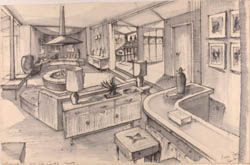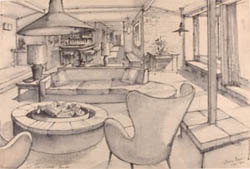mastering design
Interior of Sir Clive's House
1964
Ink on cold-press watercolor paper
Designers' drawings are functional objects, and seldom made with long-term survival—far less permanent display—in mind. In the television industry such drawings have historically had a poor survival rate. While around 400 images remain among Harry Pottle's design effects, a number are Photostats rather than original drawings, and in toto the archive is at best unevenly representative of Harry Pottle's whole career. For this reason, the two drawings for "Sir Clive's house," in an early episode of The Avengers, are exceptional in terms of more than their beauty.
Among the relatively small number of extant drawings associated with The Avengers, there are none from Harry Pottle's work on the first filmed episode in the 1964-5 series, "The Murder Market," except the isometric drawing of Steed's apartment. The drawings for "Sir Clive's house" from the following episode, entitled "The Master Minds," [fig. 11] are unusually highly finished for Pottle's surviving drawings for The Avengers, and unusually well preserved. This likely speaks to their role in the production process, for which there is an interesting piece of indirect testimony from Harry Pottle himself.
In an interview conducted in November 1994 by Simon Barker, co-author of Reading Between Designs, Pottle stated that The Avengers' demand for a rapid turnaround of sets was complicated by the slow delivery of scripts. Often he was forced to design a set based entirely on notes he took from an oral description given to him by the script editor or writer. By way of example, Pottle alluded to his design for Sir Clive's house:
I'd be on the phone to Brian Clemens [script editor] at the weekend. He'd say: "There's a stockbroker who lives in Surrey in a ranch-style house—you go in and there's a lounge with a bar in it and a view over the garden, a corridor, a bedroom at the end..." and so on. They'd be writing the scripts over the weekend and I'd have to have the sets designed by Monday!
The two drawings of Sir Clive's house are unique among Pottle's surviving designs for The Avengers in Pottle's choice of support: they are drawn on substantial cold-press watercolor paper rather than thin "newsprint" sketching paper. The drawings are also alone in showing complementary views of the same space. It seems clear that these were meant as demonstration pieces, enabling the director, cinematographer and set decorator to envisage intended effects and possible shots rather than serving as guides for the draftsmen in Pottle's art department. This may explain why they survived: many of Pottle's more technically-oriented isometrics must have become worn and quite possibly damaged as they were passed from hand to hand during the production process.
Within both drawings of Sir Clive's sitting room there are subtle hints at the way the set might be lit, suggestions of textures and fabrics to be used in construction, and references to specific furnishings the set decorator should gather in order to fill the empty space once constructed. It seems likely that Harry Pottle's design incorporated furnishings that were already known to him from stock at Elstree Studios or affiliates. The circular, cowled fireplace, for example, is a motif that Pottle used in many of his designs [fig. 12], as are the assertively modernist, curvilinear chairs. This pragmatic approach to design surely stemmed from Pottle's extensive experience in designing for "three-weekers," the fast production schedule of which must have required Pottle and his colleagues to become familiar with a repository of easily available props. It is worth noting in this context that whole sets could sometimes be reused with appropriate re-dressing. For example, the unforgettable Interrogation Room from "Quick-Quick Slow Death" was deployed again, suitably transformed into a storage closet, in the next episode to be shot, "The Danger Makers." [fig. 13]
While the two drawings for Sir Clive's sitting room in "The Master Minds" are unusual in the ways already noted, Pottle's continued use of brush and wash (usually within reinforced outlines) in a number of subsequent sketches for The Avengers. Many of these brush-and-wash drawings are also straightforwardly perspectival rather than isometric, and in at least one case there is more than one sketch extant, showing the evolution of the design. Again, we may suppose that the purpose of these drawings was demonstrative rather than technical.


